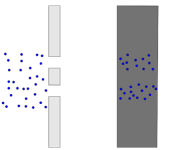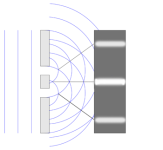Particle Physicists Puzzle Over a New Duality:
A hidden link has been found between two seemingly unrelated particle collision outcomes. It’s the latest example of a mysterious web of mathematical connections between disparate theories of physics.
The formulas, called scattering amplitudes, give the probabilities of possible outcomes of particle collisions. One of the scattering amplitudes represented the probability of two gluon particles colliding and producing four gluons; the other gave the probability of two gluons colliding to produce a gluon and a Higgs particle.
“I was getting a little confused because they looked kind of similar,” said Dixon, who is a professor at Stanford University, “and then I realized that the numbers were basically the same — it’s just that the [order] had gotten reversed.”

 www.quantamagazine.org
www.quantamagazine.org
Mathematics revealed to Dixon what some might consider counterintuitive.
The antipodal duality is the recent discovery.
A somewhat more familiar mystery of quantum physics: the dual slit experiment. Light passing through dual slits about a wavelength apart would create the following pattern if light is composed of particles (photons).

BUT !!
If light is transmitted in waves, the illustration below predicts a different pattern.

Many thanks to https://plus.maths.org/content/physics-minute-double-slit-experiment-0
for their superb illustrations.
For more on the dual slit: https://plus.maths.org/content/physics-minute-double-slit-experiment-0
The antipodal duality may summon to mind Quantum entanglement sometimes called entwined particles. This phenomenon tests our concept of space-time, because regardless of the physical distance between entwined particles, they act / react simultaneously. This would seem to mean the information between one and the other is instantaneous, faster than the speed of light (SOL).
Quantum Physics Anyone?
A hidden link has been found between two seemingly unrelated particle collision outcomes. It’s the latest example of a mysterious web of mathematical connections between disparate theories of physics.
The formulas, called scattering amplitudes, give the probabilities of possible outcomes of particle collisions. One of the scattering amplitudes represented the probability of two gluon particles colliding and producing four gluons; the other gave the probability of two gluons colliding to produce a gluon and a Higgs particle.
“I was getting a little confused because they looked kind of similar,” said Dixon, who is a professor at Stanford University, “and then I realized that the numbers were basically the same — it’s just that the [order] had gotten reversed.”

Particle Physicists Puzzle Over a New Duality | Quanta Magazine
A hidden link has been found between two seemingly unrelated particle collision outcomes. It’s the latest example of a mysterious web of mathematical connections between disparate theories of physics.
Mathematics revealed to Dixon what some might consider counterintuitive.
The antipodal duality is the recent discovery.
A somewhat more familiar mystery of quantum physics: the dual slit experiment. Light passing through dual slits about a wavelength apart would create the following pattern if light is composed of particles (photons).

BUT !!
If light is transmitted in waves, the illustration below predicts a different pattern.

Many thanks to https://plus.maths.org/content/physics-minute-double-slit-experiment-0
for their superb illustrations.
For more on the dual slit: https://plus.maths.org/content/physics-minute-double-slit-experiment-0
The antipodal duality may summon to mind Quantum entanglement sometimes called entwined particles. This phenomenon tests our concept of space-time, because regardless of the physical distance between entwined particles, they act / react simultaneously. This would seem to mean the information between one and the other is instantaneous, faster than the speed of light (SOL).
Quantum Physics Anyone?